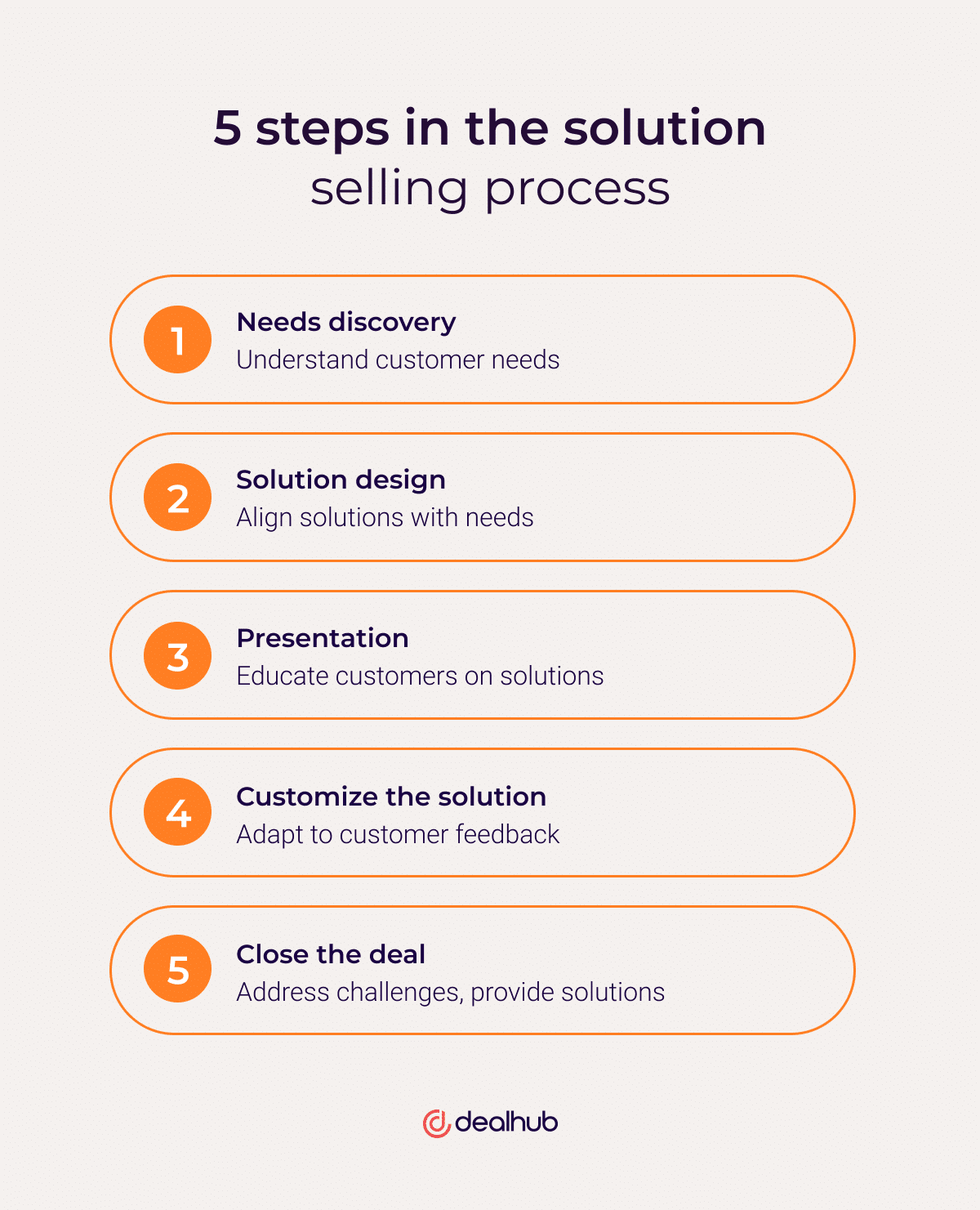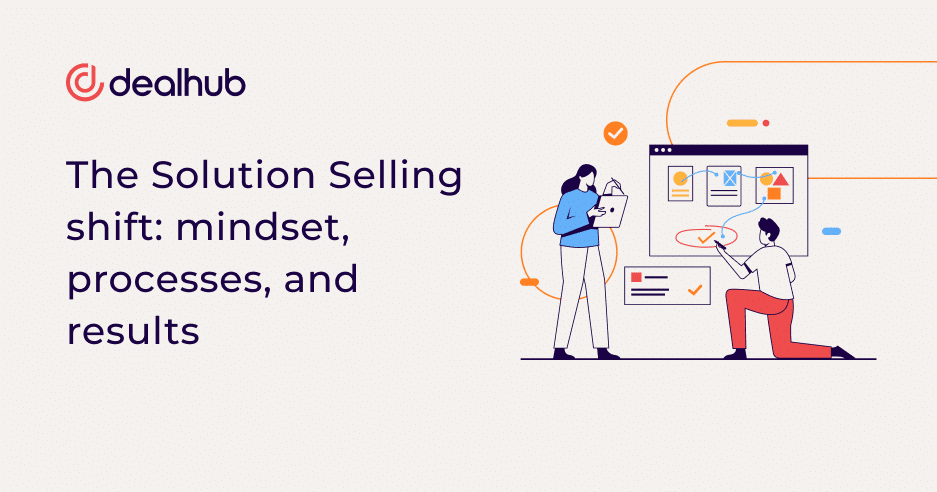Customer-centricity: embracing a Solution Selling mindset
Solution selling is not just a sales tactic; it’s a mindset that puts the customer at the heart of everything we do. Gone are the days of pushing products and features onto customers. Instead, solution selling is about actively listening, empathizing, and collaborating to understand a client’s pain points and distinctive needs.
Shifting from a product-focused mindset to a customer-centric one is pivotal in successful solution-based selling. It’s about realizing that selling isn’t just about convincing customers to buy; it’s about guiding them toward the right solution to meet their unique challenges.
Empathy is the secret sauce of solution selling. By actively listening to your clients and asking the right questions, you can uncover their pain points and gain valuable insights into their needs. This understanding forms the foundation for offering personalized solutions that resonate with them.
Gone are the days of merely presenting product features. Solution selling involves adopting a consultative mindset where sales professionals act as trusted advisors. By understanding an customer’s singular situation, sales teams can provide timely, tailored insights and guidance throughout the buying journey.
Trust is the currency of customer relationships. Solution-based selling is not just about making a one-time sale; it’s about building long-term relationships based on trust and ensuring customer success. Sales teams can foster lasting partnerships by consistently delivering value and demonstrating genuine care.
5 steps in the Solution Selling process
There are five key stages of the solution-selling process. To put the customer at the center of the selling process (instead of the product), sales representatives flow through these steps:

- Needs discovery: This initial stage involves asking the right questions and actively listening to understand the customer’s pain points, challenges, and goals. The more a sales representative knows, the better they can tailor solutions to meet a client’s needs.
- Solution design: After uncovering the customer’s needs, it’s time to design a solution that aligns perfectly with their requirements. Demonstrating the value proposition of the product offering is crucial during this stage.
- Presentation: Educating the prospective customer about the solution through a comprehensive and engaging presentation helps a client understand how the product addresses their specific pain points.
- Customize the solution: Flexibility is vital in the solution-selling process. During the presentation, sales representatives must be open to feedback and ready to adapt the solution to better fit the customer’s needs and preferences.
- Close the deal: Finally, it’s time to seal the deal. Sales representatives can approach the closing stage confidently, knowing they have genuinely addressed the customer’s challenges and provided the best possible solution.
Best practices for implementing Solution Selling
Successfully adopting solution-selling techniques requires a thoughtful approach and a commitment to customer-centricity. There are common challenges, however, as we’ll soon see, they can easily be overcome by implementing best practices.

Common challenges
Here are some typical hurdles that organizations may encounter during the implementation process:
Resistance to change: Some sales professionals may be resistant if they have been accustomed to a product-centric sales approach for a long time. However, overcoming this resistance and getting buy-in from the entire sales team is crucial for successful implementation.
Complexity of transition: Transitioning from a traditional sales model to solution selling techniques can require substantial training and support. Sales professionals must learn new skills, such as active listening, consultative selling, and customizing solutions for solution-selling to work.
Aligning sales and marketing: In a solution-selling approach, marketing plays a more significant role in providing valuable content, case studies, and materials that address customer pain points. Sales teams used to being siloed from marketing may need assistance finding a way to work more closely with their colleagues.
Longer sales cycles: Solution selling involves understanding customer needs deeply and customizing solutions accordingly. As a result, sales cycles may become longer compared to a traditional product-centric approach. Sales teams need to adapt to playing the long game, which is a significant shift for those used to quick wins.
Overcoming price objections: As solution selling often involves offering more comprehensive and tailored solutions, the price of the offering may be higher than a standard product. Sales teams must be ready to handle price objections and effectively communicate the customized solution’s value.
Data and information management: With solution selling, sales professionals need access to customer information and insights. Managing and organizing this data effectively can be challenging, especially without the right technology and tools.
Metrics and performance measurement: Traditional sales metrics may only partially capture the effectiveness of solution selling. Sales leaders may need to rethink their performance measurement approach and identify new metrics that align with a customer-centric sales strategy.
Once you’ve acknowledged the challenges of implementing solution selling, it’s time to transition towards putting customer-centric sales into use effectively. Many of the best practices directly address concerns companies may have with the initial implementation. To effectively transition towards a customer focus, companies must:
Integrate with existing sales methodologies
Solution selling doesn’t have to replace your current sales methodologies; instead, it can complement and enhance them. Integrate solution-selling principles into existing processes for a seamless transition. You’ll reduce a sales representative’s resistance to change by marrying your traditional product-focused approaches with customer-centric methodologies.
Establish a customer-focused sales culture
Creating a customer-centric sales culture is essential for the success of solution selling. Encourage a culture that values customer success, active listening, and continuous improvement. From the outset, invest time in training and building a knowledge base to ensure present and future sales representatives are able to put customer experience at the center of sales.
Leverage technology
Sales enablement, Configure Price Quote (CPQ), and Customer Relationship Management (CRM) systems can streamline the solution selling process, making it more efficient and effective. By leveraging technology, you’ll address challenges surrounding data and information management, metrics, and performance measurement.
Build RevOps alignment
Effective collaboration between sales, marketing, and customer success teams is critical to delivering a consistent and cohesive customer experience. By building transparency into processes and using RevOps and marketing to holistically support sales (using data and technology), each team will better understand their role in the overall strategy and how they can enhance and augment the sales process to drive results.
Empower sales teams
Provide sales teams with the necessary skills, resources, and autonomy to confidently build domain expertise and navigate the solution selling landscape. Introduce sales enablement processes to successfully support your sales representatives every step of the way. This includes implementing training and coaching opportunities and providing sales teams with a knowledge base and practical communication tools to facilitate information sharing while learning on the fly.
Focus on continuous improvement
Nurture a culture of continuous improvement by actively seeking feedback, analyzing results, and adapting strategies accordingly. Gathering relevant data points can reveal bottlenecks and effective techniques so sales, marketing, and RevOps can continue optimizing their approaches.
Drive results through Solution Selling
By embracing a customer-centric solution-selling approach, you can experience a profound impact on sales revenue, customer retention, and satisfaction. Solution selling enhances competitive advantage and differentiates your company’s offerings in a crowded marketplace.
A shift towards solution selling is a game-changer in the world of sales and will drive revenue growth in the long run. Remember: customer-centric sales is simply about understanding your customers, empathizing with their challenges, and providing personalized solutions that deliver genuine value. By embracing this customer-centric mindset and implementing the best practices outlined here, sales teams can confidently navigate the evolving sales landscape and achieve remarkable results.









